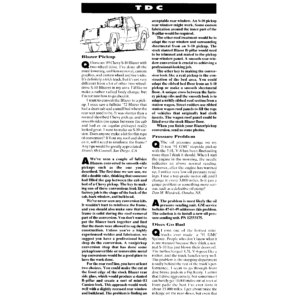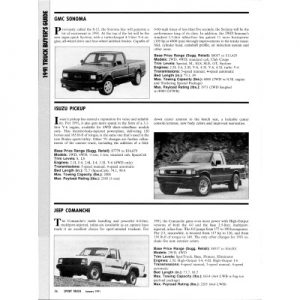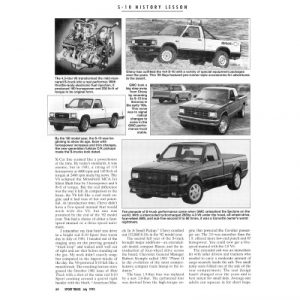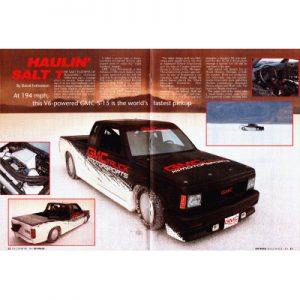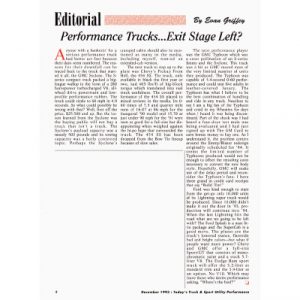High-Tech Performance
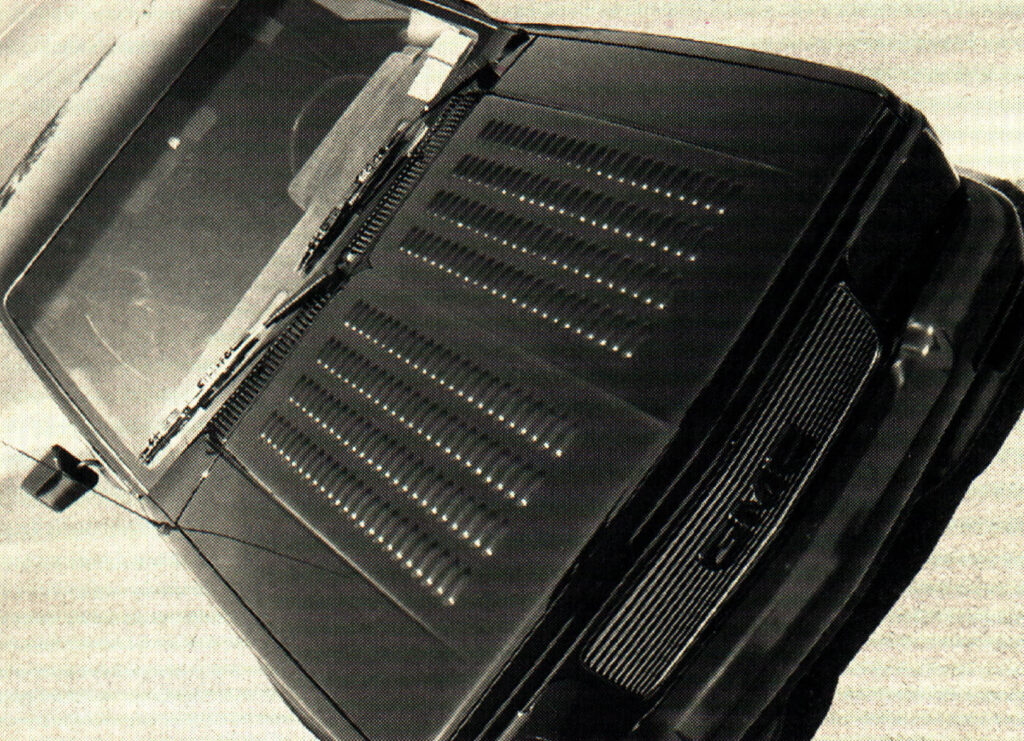
Remember the GMC Syclone? If not. you missed one of the fastest vehicles produced by a major manufacturer in the last 10 years. Eric Musnick, the owner of the Syclone featured here. didn’t, really know about Syclones until he passed a GMC dealership that had two silting on the lot. The dealers had written ”0-60 in 4.3 seconds” on the windshield, and the numbers got Eric’s attention; hut he was equally impressed by the appearance of the little trucks. He was skeptical about the accelerations claims on the window, though.
Believe, my good man! Believe! In the Nov. ’90 issue of Car Craft, a Syclone got repeated quarter-mile times in the 13.06-13.08 range. It was a preproduction model that was a little quicker than the production versions that came out in January. But the production versions are still 13-second trucks that will stay door to door with the LT1 Corvette, Buick turbo and fourth-generation F-body. In fact, it doesn’t take too many modifications to transform the Syclone into a 12-sccond vehicle. First, a little history.
During the late ’80s, GMC wanted some recognition. It wanted to stand out from the other divisions at GM, and making an engineering tour de force was the best way. It would not only make the automobile community take notice, but it would allow the engineers to have fun, to create what they dreamed of. Now only would the project change the public’s perception of GMC. but people within the company would have a greater sense of pride. This is exactly what the Viper did for Chrysler.
The engineers were dreaming of a compact truck that was faster than anything, handled like a Camaro, braked better than a Ferrari, and was able to continue the performance regardless of the weather. They built it and called it Syclone. Syclones came in any color as long as it was black. Underneath was a Sonoma pickup, but the similarities quickly disappear. The first thing one notices is the look of the Syclone: it’s an inch lower than the Sonoma and rides on meaty 245/50VR-16 Firestone Firehawk SVXs mounted on flashy 16×8 wheels. It has its own front facia that flows into body-side moldings and its own rear bumper. The bed is almost useless in the Syclone because the truck is meant to haul ass, not concrete. The bed is hidden under a tonneau cover. and “Syclone” is plastered in red graphics on the rear, the sides and the windshield. Eric describes his truck as pretty. He is partially right. It is a visually appealing truck. but it doesn’t have that sunny spring day appearance that “pretty” brings to mind. It has a darker, more sinister. hunkered-down-on-its-tires look, which lends to its performance image.
Eric personalized the look of his truck by removing the Syclone decals and adding darkened headlight covers. The only major change is the custom louvered hood by Curt O’Steem of Downsville Auto Radiator (Downsville. N.Y.). But when Syclones come up in conversation. it’s usually not their appearance that is discussed, but their ability to accelerate. The heart of the performance is the turbocharged Vortech V6. The 4.3-liter (262-cubic-inch) Six is essentially a 350 with two cylinders removed. The engine in the Syclone uses Corvette-derived hypereutectic pistons that give the engine 8.35:1 compression. With the strains of turbocharging on the engine, a Syclone-specific relief spring is installed in the oil pump to ensure adequate oil pressure to supply the engine bearings and the turbocharger. Keeping windage to a minimum is a baffled oil pan along with a special oil drainback valve in the pan itself. Because of the further cylinder pressure induced by the turbo, an extra-thick composite fire-ring head gasket was used.
The induction system on the Syclone also differs from the standard Vortech. It uses a 2-piece aluminum casting that has all the outlets and bosses for electronic engine management, including a MAP sensor. And instead of the throttle-body-type injector, the Syclone uses multiport fuel injection with a separate Delco/Bosch injector per cylinder.
But the key to the engine’s power is the Mitsubishi water-cooled turbocharger. The Delco electronic management regulates the wastegate and allows a maximum of 14 psi of boost. The air-to-water intercooler lowers the intake temperature and consequently helps the engine deliver more power. The intercooler is not dependent on the radiator coolant for its water supply, allowing its source to be cooler. All this translates to 280 hp at 4400 rpm and 360 lbs.-ft. of torque at 3600 rpm for a stock Syclone.
Eric’s isn’t stock. He added a chip. Chips maximize the timing and fuel delivery, but on turbo engines they also maximize the turbo’s boost through the electronic management of the wastegate. This does get more power from the engine, but it also increases the chances of something going wrong. In Eric’s case, a bad batch of gas combined with the chip caused a problem. He started hearing some odd noises from the engine and took the truck to Turbo People (Hastings, N.Y.), where it was diagnosed with a blown piston and a bent rod.
Looking on the bright side, it was the perfect opportunity to extract more power. While the truck was in the shop, the cylinders were bored .030 over and TRW pistons were installed. The heads were slightly ported, and a larger Turbonetics wastegate was installed, as was a Turbonetics boost control. The car has a Kenne Bell exhaust system and intake. The air-to-water intercooler was replaced by a larger air-to-air Kenne Bell unit because it was more efficient. A pair of Bosch fuel pumps and a Kenne Bell adjustable fuel regulator were also added. The truck would easily run the quarter-mile in the high 12s, but we will never know because Eric doesn’t try to push the Syclone.
How sad, because it doesn’t get any easier to extract performance from a vehicle like the Syclone. With its 4-wheel drive and automatic, you just put your foot on the brake and get on the gas until the boost rises. Then release the brake and prepare to get catapulted toward the horizon.
The 4-wheel-drive system is the same as the one used in the Chevrolet Astro/GMC Safari. The front and rear differentials have a 3.42: 1 gear, but the rear has a limited slip. Torque is split 35 percent front and 65 percent rear-until the vicious clutch senses slippage and sends power to where it’s needed. The transmission is a 4-speed R4L60 700R-4 from the Corvette, but with modified shift points.
The Syclone really shines at the strip, especially for a novice, since traction is never a problem. There is no need for slicks because the 4-wheel drive delivers monstrous amounts of grip. The Syclone is the perfect vehicle for those who want maximum acceleration with minimum exertion.
The truck shines in every area of performance. Braking is done via a disc/drum arrangement with a Kelsey/Hayes-developed anti-lock system. It makes do with rear drums because only 37.1 percent of its weight is over the rear wheels. As we stated before, it outbrakes a Ferrari 348ts, and the fellows at Car And Driver proved it in their Sept. ’91 comparison test. Yes, they compared a Ferrari to the $96,000-cheaper Syclone, and the GMC truck outperformed the Ferrari in every category except top speed and skid pad.
Eric says, “At my age (55), things usually don’t impress me, but this is a thrill.” He bought the truck on impulse and has never regretted it. Some may get angry because he doesn’t drive it hard, but he loves it too much. Eric feels guilty if he has spent a day pushing it on the highway. It is probably for the best because he plans on keeping the Syclone forever.

